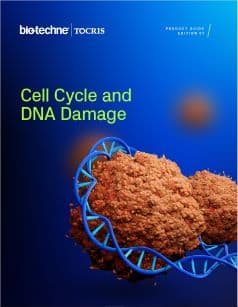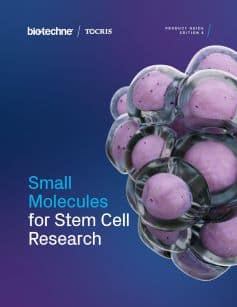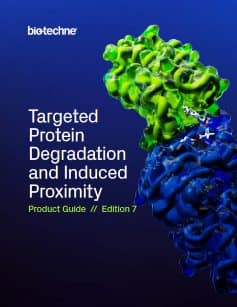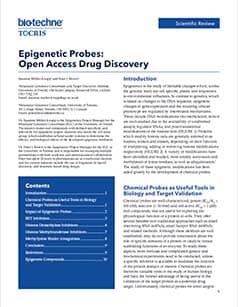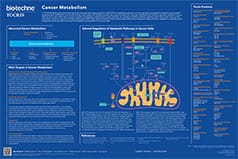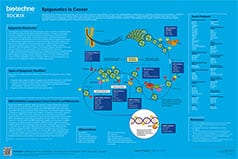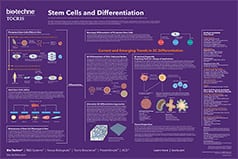Breast Cancer
Breast cancer is the most frequent malignancy in women, contributing to 11.7% of all new cancer cases and 6.8% of all cancer-related deaths worldwide in 2020. Whilst medical interventions and diagnoses are a major focus of the breast cancer field, extensive research surrounding the inherent biology of breast cancer remains ongoing.
Jump to product table
Breast Cancer Product Areas
Breast cancer is a heterogeneous disease that can be divided into several molecular subtypes defined by the expression of specific receptors namely: Luminal A/B, Basal-Like, Human Epidermal Growth Factor Receptor positive (HER2+) and Triple Negative Breast Cancer (TNBC) (see Table 1). HER2+ and TNBC are the least common subtypes but are associated with a poorer prognosis and higher mortality rate than the other subtypes. Initial diagnosis of breast cancer subtype is through histology and immunohistochemistry, which defines treatment strategies (Table 2).
Table 1. Breast cancer molecular subtypes.
Each subtype can be characterized by the expression of estrogen, progesterone and HER2 receptors. The expression of a particular receptor within a subtype is indicated by '+', absence of a particular receptor is indicated with '-'.
| Receptors | |||
|---|---|---|---|
| Subtype | Estrogen | Progesterone | HER2 |
| Luminal A | + | + | - |
| Luminal B | + | + | + |
| HER2+ | - | - | + |
| TBNC | - | - | - |
The genomics of breast cancers have been thoroughly dissected revealing the heterogeneity in driver mutations. Studies have identified further subtypes within HER2+ and TNBC tumors, allowing stratification of these tumors and more refined treatment options. Inhibition of distinct pathways can be used in research to mimic treatment and show how tumor sub-populations adapt and respond. For example, Lapatinib (Cat. No. 6811), a HER-2 inhibitor, and Avagacestat (Cat. No. 6363), a γ-secretase inhibitor, have been used to explore the dynamics of HER2 heterogenous tumor populations and the resulting tumor response and adaptation. Another strategy uses targeted protein degradation to knockdown specific proteins in cells. For example, the PROTAC® Degrader SJF 1528 (Cat. No. 7262) degrades HER2 and EGFR and can be used to understand cancer pathways and responses to the degradation of these proteins.
Table 2. Histological breast cancer subtypes
| Histological subtype | Ductal | Lobular |
|---|---|---|
| Preinvasive (25%) Cells are limited to the basement membrane | Ductal carcinoma in situ Likely to spread through ducts and cause distortion of structure Tends to be unilateral Small proportion progress to invasive | Lobular carcinoma in situ No distortion of duct structure Genetic E-cadherin loss Can be bilateral |
| Invasive (75%) Cells extend beyond the basement membrane | Invasive ductal carcinoma Usually progression from ductal carcinoma Fibrous, palpable mass Lymph and blood metastasis | Invasive lobular carcinoma Metastasis to GI, ovaries, uterus Less fibrosis or palpable mass Usually ER+ |
RNA in-situ hybridization (ISH) approaches are increasingly being applied to improve subtype characterization and to direct therapeutic selection. RNAscope™ is an example of this technique, allowing for biomarker identification, tumor subtyping and expression analysis, in addition to many other research applications. For example, RNA probes for EGFR and ERBB2 could be used to understand the transcriptional changes and responses within a cancer cell to treatment with Lapatinib. Combining these RNA-based assays with compound screens can also be a way to identify new genes, drugs of interest, or novel drug effects.
Despite the enormous heterogeneity, there are some genetic changes that are characteristic amongst several breast cancers and between different subtypes. Some of the most frequently mutated genes include oncogenic/hyper activation of PIK3CA, MAP2K4 and KMT2C, and loss of tumor suppressors such as TP53 and PTEN. BRCA1/2 mutations and their role in the increased familial risk of breast cancer is well established; mutations in BRCA1/2 and other DNA damage response (DDR) genes are frequently observed at later stages of breast cancer tumorigenesis. As a result of this, BRCA-deficient cells are reliant on other DNA repair pathways that can create therapeutic vulnerabilities, for example the RAD52 inhibitor 6-Hydroxy-DL-DOPA (Cat. No. 5740) inhibits proliferation in BRCA-deficient cells.
The ability of cancer cells to adapt and evolve is a key to therapeutic resistance and relapse. For example, inhibition of poly(ADP-ribose) polymerase (PARP) by Veliparib (Cat. No. 7026) is effective in treating tumors but resistance can develop. Using cell culture or breast tumor organoids, an understanding of the mechanisms of resistance to Veliparib and the adaptive use of other pathways could be gained. Drug combinations and synthetic lethality can also be studied in this way. For example Trastuzumab and Iressa (Cat. No. 3000) are known synergistic drug combinations, effectively inhibiting breast cancer cells across several subtypes.
PROTAC® is a registered trademark of Arvinas Operations, Inc., and is used under license.
New and Top Products for Breast Cancer Research
Click product name to view details and order
| Target | Top Products | New Products |
|---|---|---|
| ALK | A-83-01, SB 216763 | TL 13-12, TL-13-112 |
| mTOR | Torin 1, Torin 2 | |
| AURKB | ZM 447439, TC-A 2317 | |
| CTNNB1 | XAV 939 (available sythesized to cGMP guidelines), iCRT 14 | xSTAx-VHLL |
| BRAF | SB 590885 | CG 858 |
| MET | PHA 665752 | |
| HSP90 | VER 155008 | |
| MDM2 | SP 141, Nutlin 3a | |
| SRC | A 419259 | ND1-YL2 |
| Wnt | PKF 115584 (Calphostin C), FH 535 | |
| MYC | KJ Pyr 9 | |
| CDK4/6 | BSJ-03-204, Ribociclib | BSJ-04-132 |
| RAR | BMS 753 | |
| PIK3CB | LY 294002 hydrochloride, Wortmannin | |
| MEK1 | SL 327 | |
| FOXM1 | RCM 1 | |
| BRD4 | (+)-JQ1, MZ 1 | |
| STAT3 | Stattic, NSC 74859 | HJC 0416 |
| ESR1 | ICI 182,780, G-1 | |
| FOXA1 | (+)-JQ1 | |
| PARP | SK 575, Olaparib | |
| Bcl-xL | A 1331852 | |
| ErbB2/HER2 | Tucatinib | HER2 PROTAC® CH7C4 |
| LMTK3 | C28 |
